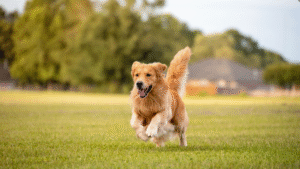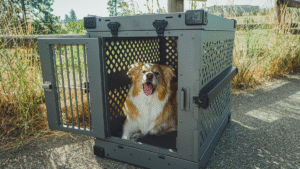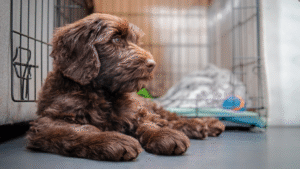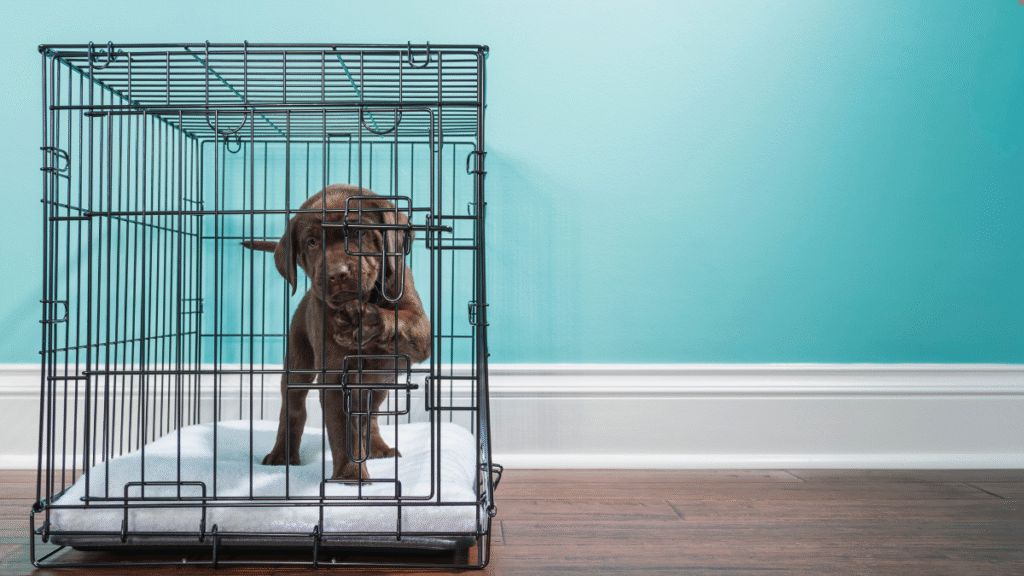When it comes to essential dog training tools, few things rival the power of a well-placed crate. For puppies, new dog parents, or even experienced owners with rescue dogs, crate training can add structure, safety, and confidence to your dog’s life.
The problem? Many owners simply get it wrong—or don’t stick with the process long enough to see results.
The good news? Crate training is much easier than it seems. With a few positive, behavior-based hacks up your sleeve, your dog can learn to love the crate as much as you do.

1. Make the Crate Feel Like Home — Not a Cage
Rule number one of crate training is simple: Help your dog want to be there. The worst thing you can do is grab your dog and force them into a crate as if it’s a punishment.
Instead, your dog’s crate should feel cozy, den-like, and inviting. Set it up with a soft blanket, a crate pad, or a small bed to make it feel like home. You can even drape a cover or towel over part of the crate to create that secure, den-like atmosphere.
Remember — dogs are den animals by nature. They like enclosed spaces, especially when the environment feels comfortable and familiar.
Here are some easy ways to make crate training feel natural:
-
Put the crate in a quiet area of your main living space. Choose a spot where your dog feels part of the action but still has their own personal retreat.
-
Add familiar scents. An old T-shirt with your scent can work wonders for helping your dog relax.
-
Keep it simple at first. Don’t overload the crate with toys and blankets. Start minimal and see what helps your dog settle best.
The more your dog views the crate as their own special “den,” the easier the entire training process will be.

2. Associate the Crate with Positive Experiences
Dogs are smart — they learn from every interaction. You want crate training to be one of the most positive experiences in their life.
That starts with never forcing your dog into the crate. Make them want to go inside. One of the most effective hacks is to feed your dog their meals in the crate. Start by placing the food bowl or puzzle toy near the crate entrance, then gradually move it farther inside.
Your dog will follow their nose and step in willingly. Over time, this becomes routine—and your dog will go inside without prompting. That’s the foundation of true positive association.
Here are a few more ways to make the crate a rewarding place:
-
Offer a high-value treat every time your dog enters the crate voluntarily. Small pieces of cooked chicken or cheese work great.
-
Use interactive toys and food puzzles to keep them mentally engaged inside the crate.
-
Give your dog a safe chew, like a frozen KONG stuffed with peanut butter, when you close the door.
Never use the crate as punishment. If your dog is always sent there for bad behavior, they’ll associate it with negativity instead of safety. The crate should never feel like a “time-out” zone—it should be their comfort zone.
The more positive experiences your dog has in their crate, the faster they’ll learn to love it.
3. Start Small and Build Consistency
A common crate training mistake is expecting too much too soon. If you try to get your dog to stay calmly in the crate for hours right away, you’re setting yourself—and your dog—up for frustration.
The secret to crate training success is slow, steady progress. Think of it as building trust, not demanding obedience.
Start by leaving the crate door open and letting your dog explore it at their own pace. Reward any interest—sniffing, stepping inside, or lying down—with treats or praise.
Once they’re comfortable, close the door for just a few seconds, then open it and reward their calm behavior. Gradually increase the closed-door time—30 seconds, 1 minute, 5 minutes, and so on—always rewarding relaxation.
It’s also helpful to practice leaving the room for short periods while your dog is in the crate. Return before they get anxious and reward them for staying calm. This teaches your dog that you always come back and that being alone isn’t scary.
If your dog whines or scratches, wait for a quiet pause before opening the door. Reward silence and calmness, not fussing.
Remember, the crate is not meant to contain your dog—it’s meant to build their confidence and independence.

4. Choose the Right Crate Size and Setup
Believe it or not, the type and size of crate you choose can dramatically impact your dog’s success.
A good rule of thumb: Your dog should be able to stand up, turn around, and lie down comfortably—but not have too much extra room.
A crate that’s too small feels cramped and stressful. A crate that’s too large can encourage bad habits, such as peeing or pooping in one corner and sleeping in another.
For puppies, use a crate divider to adjust the space as they grow. This allows the crate to “grow” with your dog and prevents accidents or anxiety caused by too much open space.
Here are a few more setup tips:
-
Use a sturdy, well-ventilated crate — wire or plastic are both fine.
-
Avoid direct sunlight or drafts. Keep the crate in a comfortable temperature zone.
-
Add a water bowl or no-spill dispenser if your dog will be in there for longer sessions.
-
If you travel often, get your dog used to both a home crate and a travel crate so the experience feels consistent.
The right setup creates comfort and predictability—two things every dog craves.
5. Create a Routine Around the Crate
Dogs thrive on routine. When crate time becomes a predictable part of their day, it reduces stress and helps them settle in faster.
Try this simple schedule:
-
Morning: Short crate session while you prepare breakfast or shower.
-
Midday: Naptime in the crate after a walk or play session.
-
Evening: Quiet crate time before bed or while you relax.
Pair crate time with calm, low-energy moments. Avoid using the crate during times of high excitement or play, as that can make your dog restless inside.
It’s also smart to combine crate training with exercise and mental enrichment. A well-exercised dog is naturally more relaxed and content, which makes crate time peaceful rather than stressful.
If your daily routine isn’t always perfect, that’s okay. What matters most is consistency and predictability. Dogs don’t need perfection—they just need to know what to expect.
Crate Training Science: Why It Works
The effectiveness of crate training comes down to a mix of biology and behavioral science.
Dogs are den animals by instinct. In the wild, they seek out small, enclosed spaces to rest and feel safe. A properly introduced crate replicates that natural instinct—it becomes a private sanctuary for your dog to decompress, nap, and feel secure.
When used correctly, crate training also:
-
Prevents destructive behavior when you’re not home
-
Supports house training, since dogs typically avoid soiling their sleeping areas
-
Builds confidence and independence, especially for dogs with separation anxiety
-
Provides safety and comfort during travel or vet visits
Simply put, crate training works because it aligns with what dogs naturally need—a safe, predictable, personal space.

Final Thoughts
Crate training is one of the most misunderstood parts of dog ownership. It’s not about “locking up” your dog or isolating them. When done right, it’s about structure, security, and confidence.
With patience and consistency, your dog can learn to love their crate—and you’ll gain peace of mind knowing they have a safe, comfortable place to relax.
In time, that little crate will become much more than a training tool—it’ll be your dog’s favorite spot in the house.
- 5 Cheap Alternatives To Dog Training Equipment - November 12, 2025
- Homemade Calming Spray To Help Dogs During Training - November 12, 2025
- 7 DIY Dog Training Tools You Can Make From Household Items - November 12, 2025
